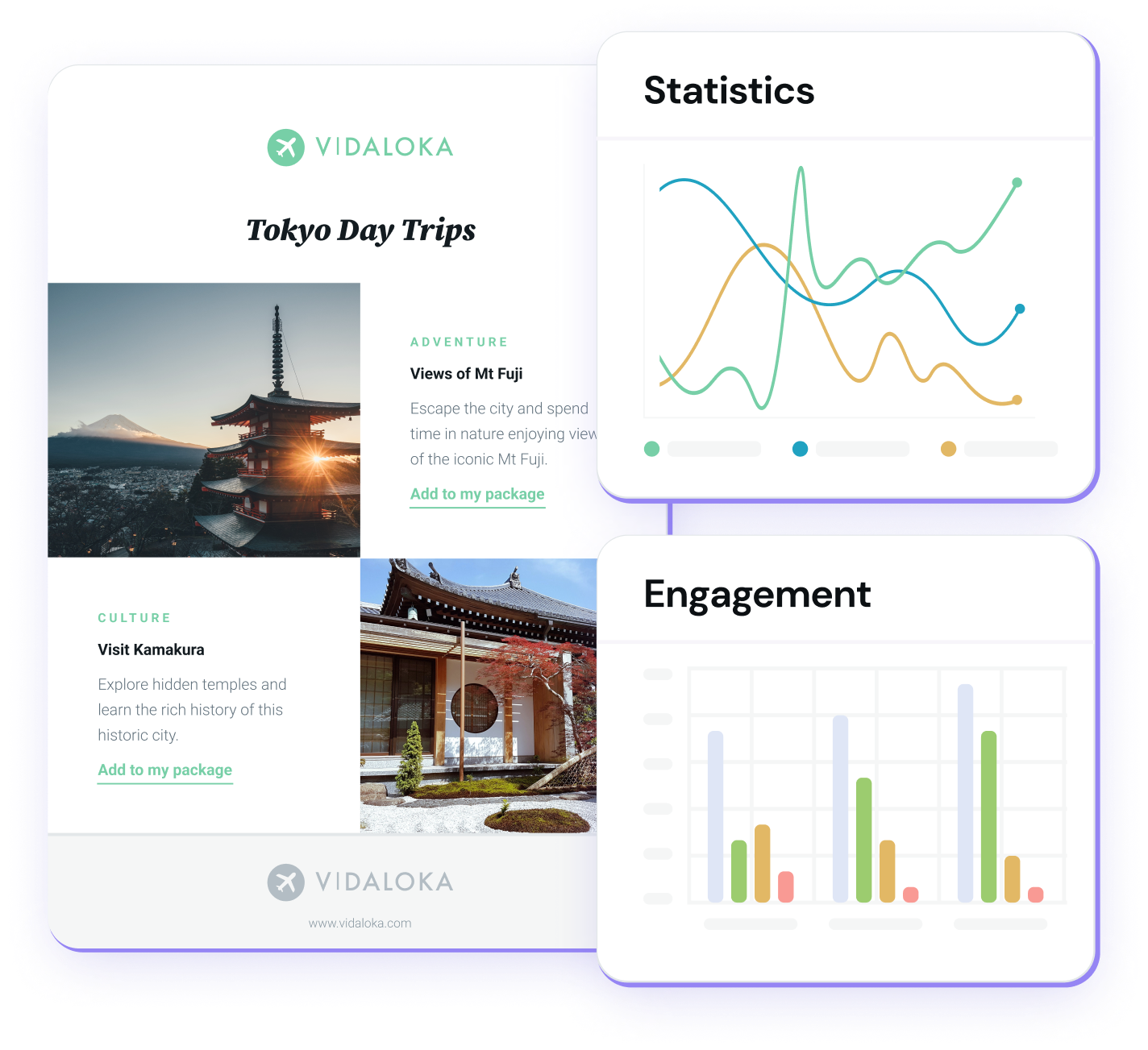Email best practices
Email link tracking to get better insights and push your strategy further
Email marketing and big data expert, Milena Mitova, outlines why you should push your email link tracking beyond the basics to get a deeper insight into how your customers interact with your brand.

PUBLISHED ON
As an email sender you understand the significance of tracking clicks and opens in gauging the success of your campaigns. Without them, it’s almost impossible to get a handle on how customers are engaging with your content.
However, there's a lot of valuable insights to be uncovered beyond these two fundamental metrics. In fact, Email UTM Link Space Expert, Milena Mitova, addressed this very point in her Email Camp session Around the ROI orbit: Automating link tracking in email marketing for better insights.
Yes, clicks and opens are great, but some of the more advanced email link tracking capabilities give marketers critical insights into customer behavior and maximize the impact of their email strategies. Want to know more? Then let’s find out what Milena had to say.
What is email link tracking?
When sending emails (transactional or marketing) to your subscribers there’s always a purpose or objective behind the message. If it’s transactional mail, a customer probably triggered an automatic response by performing an action on your website. Transactional mail includes messages like account creation details, a double opt-in, an order confirmation, password reset, or a purchase receipt.
If it’s a marketing email the objective will be different. Typically, you want to promote products or services to your subscribers, foster brand awareness, stimulate customer engagement, and ideally impact bottom line sales.
Whatever the case, you need to know whether your emails are having the desired impact or not – especially marketing emails since they are not automated or expected by customers. This is where email link tracking comes into play.
Email link tracking monitors the interactions your readers have with the hyperlinks embedded within your email campaigns. These could be links to blog posts, landing pages, product updates, or to a recently launched webinar series. While the basic premise involves recording the number of clicks on these links, the true power of link tracking lies in the ability to gather detailed data on user behavior.
Pushing your link tracking further
OK, so monitoring email clicks and opens is good, but what else is there to look at? Well, thanks to specialized tracking and analytics tools, you can actually see how much time visitors spend on clicked-through pages, and whether these interactions lead to desired outcomes such as product purchases or form submissions.
The process of tracking behavior beyond that initial click typically involves assigning unique identifiers or parameters to each link known as urchin tracking models (UTMs). Essentially, it’s a small bit of text added to a URL that can be tracked in Google Analytics, a bit like a digital breadcrumb trail, allowing you to follow a customer’s journey from an email across your entire website.
Pro tip: Interested in finding out more about UTM tagging and how to implement it in your next email marketing campaign? Then check out our detailed guide above.
While tracking user behavior might sound a little intense, if you adhere to data compliance laws such as GDPR and CAN-SPAM it’s perfectly legal. With that said, let’s explore some of these advanced email link tracking benefits in more detail.
Conversion tracking
When you create an email campaign, you do so hoping to persuade subscribers to take some sort of action. Now, this can mean many different things for different businesses. For you, it might be a sale. For the local church it might be to raise funds to repair a leaky roof.
Whatever that action might be, simply monitoring the number of clicks or opens that email receives doesn’t tell you how successful the campaign was. To do so, you’ll need to go beyond the “click” and look at set up conversion tracking for a specific goal.
By adding UTM tags to your links, you’ll be able to analyze what subscribers did after clicking on the call-to-action button (CTA) in your email. Let’s use our poor vicar and his sieve-like roof as an example.

Imagine he’s sent out an email campaign asking for church goers to donate funds. If they’re feeling generous, they’re redirected to the church's website with a link to a PayPal account they can pay into (the email campaign goal).
So, to assess its success he needs to know how visitors behave once they reach the site. Are they immediately clicking the PayPal CTA and converting? Are they navigating to the church’s home page first, and then the converting there? What is the abandonment rate? How many subscribers are clicking on the CTA before cancelling, and exiting the site?
Gathering customer journey data will help our vicar determine how conversions from his email campaign happen, allowing him to use this to make future adjustments.
Building customer profiles
We’ve established that advanced link tracking helps us understand if our email campaigns are converting, but did you know it can also help us build customer profiles? If this is the first time you’ve come across the term, a customer profile is essentially a fictional representation of your ideal customer, built using demographic information, preferences, behaviors, and other relevant characteristics.
These profiles are gold for email marketers, as they allow us to deliver more personalized and effective campaigns that we can be confident will resonate with our customer needs. However, to build these personas we need data, and what better way to source it than from our own email campaigns?
There are three types of data we can gather from customers using advanced email tracking:
Data | Tracking |
|---|---|
Data | |
Behavioral data | Clicks, scrolls, mouse movement, device, etc. |
Tracking | |
Engagement data | Impressions, replies, retweets, bounces, etc. |
Attitudinal data | Customer satisfaction, reviews, sentiments, etc. |
Behavioral data
Behavioral data is derived from tracking how subscribers interact with our campaigns. It provides a window into their preferences and interests. For example, we can track which devices or email service providers (ESPs) they use to access a campaign . Do they prefer mobile or desktop? Do they often come back to re-read content? How often are they clicking on product links without completing a purchase?
Engagement data
Engagement data includes information such as the amount of time subscribers spend on a website or landing page after clicking through an email link. High engagement times may signify a strong interest in the content, while quick exits may suggest a lack of resonance.
Attitudinal data
Though more qualitative in nature, attitudinal data uses advanced email link tracking to glean deeper insights. Some examples include survey questions or feedback responses: what do customers like about or brand? What would they improve? You might even want to include Net Promoter Score (NPS) related questions to see how likely customers would recommend you to friends and family.
According to data from Forrester, organizations using customer satisfaction data to optimize user experiences see over 1.5x higher YoY growth in customer retention and repeat purchase rates.
Defending your ROI
Organizations often need to make difficult decisions about resource allocation, budgeting, and staffing. If purse strings start to tighten you might find yourself having to justify your team’s work to the higher-ups at your business to keep your neck off the chopping block.
Knowing how to defend your email marketing ROI with data (gathered from your advanced link tracking system) is a handy little skill to have, just ask Marina...
A new VP joined Marina’s team in the IT department. Looking to make some quick wins they decided to replace the current email marketing platform (Marketo) with a new one (Mailchimp). It turned out that Mailchimp would cost about a quarter of what the team was paying for their current system.
Little did they know that they had a company-wide tracking system in place that Marina was able to use to demonstrate email’s effectiveness compared to other communication channels in their portfolio. Yes, Marketo was expensive but the return on investment (ROI) was almost 2x higher than anything else the team was using.
It was nothing personal; the incoming VP was simply looking to reallocate budget elsewhere in what they thought was a strategically sound move. However, by using the data gathered from her advanced email tracking system Marina was able to justify the channel’s expenditure and defend its place at the very top of the marketing tree.
Start Analytics Tracking with Mailjet
So, now you know, link tracking is a fundamental aspect of email marketing analytics, allowing you to optimize your campaigns, adjust content strategies, and ultimately enhance the overall impact of your email communications.
If you’d like to set up Analytics Tracking for your email marketing campaigns, you can sign up or upgrade to any Premium plan. UTM tagging is only available on Premium plans, and only applicable for email campaigns: marketing campaigns, or transactional emails grouped as a campaign.








